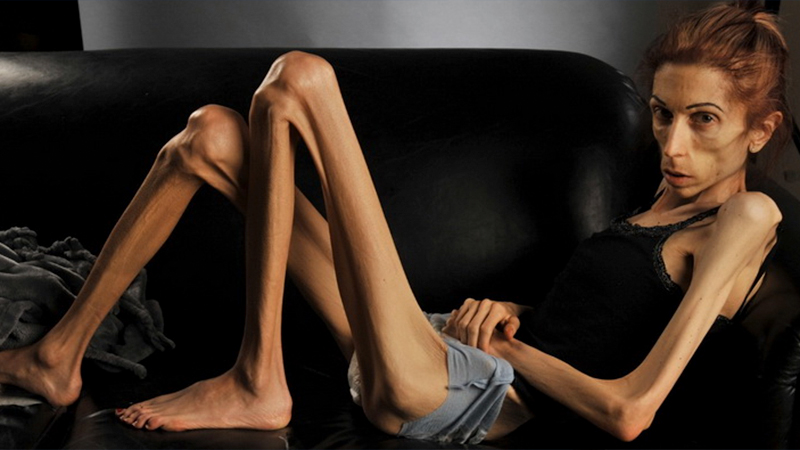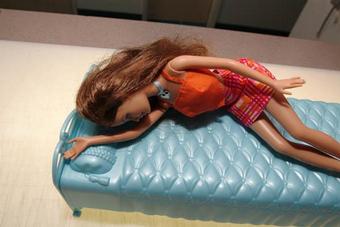Eating Disorders: Anorexia Nervosa - The Most Deadly Mental Illness

All In Her Head
Anorexia - the most deadly mental illness - is definitely not just about looking thin.
She didn't choose anorexia. I know that now, but that doesn't make it any easier to watch her starve herself, and fade away into nothing.
It's like a nightmare where you see the boogeyman and you know it's going to kill her so you warn her, but she can't see it, so she doesn't believe you, and then she dies.
But anorexia is a slow suicide. And although anorexia accounts for more deaths than any other type of mental illness, she says she's okay, she says she's healthy. Her brain has shrunk and she's losing her cognitive skills.
She's says she's not like other anorexics. She's in denial. She's moody and angry and depressed a lot of the time. She thinks her mind and body are just fine. But her heart has shrunk, too, and its resting rate has fallen to 49 beats per minute (60 to 80 beats per minute is considered healthy) and she's seen doctors for problems with her kidneys, stomach and other organs.
When she's sleeping, her heart rate will fall well below the "critical" rate of 45 beats per minute, and she may not wake up again.
It's difficult not to feel angry with her because she's hurting herself and all of the people who love her. But she's not just a skinny, stubborn, vain girl who won't eat. She's sick, with a mental illness, and she didn't choose this any more than someone chooses cancer.

A few days after Christmas, she is hospitalized. She's in treatment now, although most of the time she doesn't want to be there and she insists she can get better on her own. I try to tell her that no one looks forward to chemo, either. I don't know if she hears me or not. There are millions of other women - and men - like her in the US, walking skeletons, dying to be thin.
"Why won't she just eat the sandwich?" asks Dr. Cecily FitzGerald, an emergency physician who also treats patients with eating disorders. "She can no more eat that sandwich than you can eat that shoe.
"It's important to stress that it's not about the food, because parents, spouses, loved ones - they always feel it's just about the food. It's really not about the food."
The National Association of Anorexia and Associated Disorders says the problem has reached epidemic levels in America, and affects everyone - young and old, rich and poor, women and men of all races and ethnicities. Their statistics say seven million women and one million men are sick with an eating disorder. More than 85 percent of victims report the onset of their illness by age 20.
There are still a lot of misunderstandings about the disease, however, even among health professionals. Treatment is hard to find - few states have adequate programs or services to combat anorexia nervosa and bulimia - and it's also very expensive.
Inpatient treatment can cost about $30,000 a month, and outpatient treatment, including therapy and medical monitoring, can reach $100,000 per year or more.
"The treatment should be multi-disciplinary," FitzGerald says. "Therapy, a nutritionist, and a physician. Those are the minimum requirements - you can add to that physical therapy or art therapy. You can add as much as you see fit. But the bare-bones is the therapist/psychologist, a physician and a nutritionist."
Anorexia - as all eating disorders - is a complex disease. There's not one single, simple cause, although new research has revealed that anorexia and bulimia are inherited conditions - one needs to have a genetic predisposition for them.
"But that doesn't mean that everybody who has that gene does have, or will develop, an eating disorder," says Kirstin Lyon, a marriage and family therapist in Carmel Valley who is also a certified eating disorder specialist.
So-called environmental factors can also trigger, and worsen, the disease: our society's obsession with thinness, puberty, dieting, going away to college, a traumatic world event or a more personal one, like a breakup.
"There are usually about 10 other reasons why people get eating disorders," Lyon says, "and they all come together: control issues, perfection issues, also addiction. When all these things come together, it forms this way of coping. It's not about the food."
While most people who develop anorexia do so when they hit puberty, both Lyon and FitzGerald say they see patients of all ages. They say they treat 10 girls for every one boy.
First, it looks like body dissatisfaction. "I want to go on a diet," Lyon quotes her patients. "Or food pickiness - I want to be a vegetarian."
Sometimes it's even encouraged - "dieting and exercising are good for you; thin is beautiful," or so we are told every day.
"We live in a culture where we look at anorexically thin models and call that normal, call that attractive," FitzGerald says. "We have lost our high level of suspicion for someone who is at low weight."
By the time the disease is discovered, much damage has already been done. Hair falls out. Skin turns orange, or yellow. Teeth and gums erode. Menstruation stops. Bones become weak and brittle. The heart, kidney, liver, stomach and other organs become seriously damaged and start to shut down. The brain shrinks.
And those are only the physical repercussions. Words don't adequately describe what the disease does to her self-esteem, how badly it damages her relationships and how much it hurts the people who love her.
"Weight restoration will return most everything to normal," FitzGerald says.
About one third of anorexics recover, Lyon says. Another third may relapse and remain symptomatic. The final third are chronic.
"Their life expectancy is shorter, or they will die," Lyon says.
The ones who recover can't do it overnight. It usually takes between two and nine years. Both Lyon and FitzGerald had eating problems. Both recovered from eating disorders, and want to help other people become well.
"There were so many times when I didn't want to go [to treatment]," Lyon says, "but I just had faith that things can change. If they can for me, they can for anybody."
And both Lyon and Fitzgerald rail against the unrealistic body images on TV, in magazines and on the runways.
"It's very important for all of us - parents, teachers, men and women - to be accepting of our bodies," FitzGerald says. "I think this whole obesity epidemic is really dangerous; the amount of press that obesity is getting is leading to so much press for diets and it's such a dangerous, dangerous place to go. People need to eat what they want, when they want, and stop when they are satisfied."
It's also extremely important for parents to model body acceptance for their kids, she says. "Then they aren't so susceptible to the media, to diets. It's important for parents to point out all the ways that our culture gets women to be unhappy with themselves. Don't say, 'Do these jeans make me look fat?' or, 'I can't have dessert; it will go straight to my hips.' It's that kind of stuff that children just can't hear. They need to know that they don't need thin thighs or a flat stomach to love their body."
FitzGerald talks to her daughter about airbrushing; in fact, the two have made a game out of it.
"We go through magazines and pick out where we think the model has been airbrushed. You take a woman who is already beautiful, and even the model can't achieve this level of perfection.
"Parents, teachers, babysitters, sisters, we need to all stand up and say, 'We are happy with ourselves, our bodies, the way they are.'"
I hope she makes it to that point, and someday, will be able to say she's happy with her body and really mean it. She's begun to take the first steps, at least. But right now she's angry much of the time. She's angry at her doctors and her parents because they are forcing her to eat and attend therapy sessions. I hope someday she will be able to realize that they saved her life.
Source: Monterrey Weekly
next: Eating Disorders: Comorbidities of Eating Disorders
~ eating disorders library
~ all articles on eating disorders
APA Reference
Tracy, N.
(2009, January 10). Eating Disorders: Anorexia Nervosa - The Most Deadly Mental Illness, HealthyPlace. Retrieved
on 2025, December 6 from https://www.healthyplace.com/eating-disorders/articles/eating-disorders-anorexia-nervosa-the-most-deadly-mental-illness



